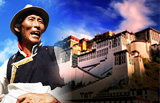Space-age food served up with seeds of success
Updated: 2012-09-03 01:30
By Xin Dingding and Jin Zhu(China Daily)
|
||||||||
Bigger and better vegetables show the benefits of cosmic farming
An eggplant the size of a basketball, and a cucumber half a meter long seem, at first glance, out of this world.
They are, literally. Chinese scientists have created more than 120 varieties of plants by sending seeds into space over the past 25 years.
The varieties are making their way to dining tables and even grabbing a market share in some areas, industry insiders said.
In Northwest China’s Gansu province, "space peppers" account for more than half of the local capsicum market, said Li Qingsheng, director of the Lanzhou office of the Tianshui Shenzhou Lushui Agricultural Science and Technology Co, a seed firm in western China.
"These ‘space peppers’ are not sold with a label indicating their uniqueness, but they still sell well at a slightly higher price than conventional ones," Li said.
Farmers like to grow them because the particular type of pepper, the Hangjiao-5, grows faster, has a higher yield, and sells well, he said.
Consumers like its thicker flesh and it has fewer seeds, he said.
The planting area of the pepper, which used seeds developed from seeds taken into space during the 2002 Shenzhou III mission, has spread to five other provinces and regions, including the Xinjiang Uygur autonomous region and Yunnan and Qinghai provinces.
Peppers are not the only beneficiaries. Eggplants, tomatoes and beans, helped by space technology, have also entered the market. But ensuring seeds can fully benefit from their time in space means a lot of work must take place on the ground.
"It’s not like that after traveling in space for a few days, the seeds will turn out with all the desired traits we want," said Liu Min, a scientist who specializes in seed technology and is also a consultant to the China Academy of Space Technology.
Breeders spend years working in the farmland, nurturing and selecting the prime seeds and just being in space is no guarantee of success.
Liu’s team sowed tomato seeds in 2005 presented by Russia as a gift. The results were mixed. They had been on the Mir space station for six years (1992-98). But the first seedlings produced both big and small tomatoes. Some did not even sprout.
They selected the good but unwanted traits continued to emerge in the second and third generations.
It was not until the fourth generation that the researchers were pretty sure that the traits were in the genes.
A new variety usually takes at least four years to create but it is still a "much faster" process than traditional breeding which can take a lifetime to make just a few new varieties, she said.
That is not fast enough as agriculture undergoes further modernization to feed a population of 1.3 billion, she said.
"More than half of all vegetable seeds bought by farmers in China are imported. The situation is pressing," she said.
Chinese scientists first sent crop seeds into space in a recoverable satellite in 1987.
Jiang Xingcun, a scientist with the Chinese Academy of Sciences who was in charge of the early experiments, found that the space environment — which apart from the lack of gravity also has a magnetic field and high energy cosmic radiation — can induce mutations in up to 12 percent of the seeds, hundreds of times the rate on Earth.
Scientists say the radiation and micro-gravity can cause natural changes to the seed. It does not involve any artificial genetic modification.
Radiation-induced mutation is an agreed safe way to breed new crop varieties, given the fact that it does not splice any foreign genes into the plants, Liu said.
A bigger percentage of mutations means breeders have a wider choice to find their desired traits.
But the program has met opposition.
Some agronomists questioned why China should experiment with space-induced mutation while the former Soviet Union and the United States have curtailed their programs.
But Liu pointed out that Russia has been using space mutation to improve crops, including cotton, wheat and firs that are used as Christmas trees.
US scientists have also used the method to improve roses so that more oil can be produced to make perfume, she said.
"It’s just one kind of radiation-induced mutation, except the radiation source is the high-energy particles in space," she said.
Chinese breeders had used Cobalt-60, a radioactive isotope, to induce seed mutation on the ground. But Cobalt-60 is highly dangerous, and scientists must get permission to use it.
Thanks to China’s progress in space, seeds of nearly 400 plant varieties have gone into space 23 times in recoverable satellites and in 10 missions of China’s manned space program, according to media reports.
A news report by Nanfang Weekly in July said that there are at least 224 research teams in various scientific institutes in China, and at least 60 breeding bases have been established.
Scientists are trying to unravel the mystery of space-induced mutation.
Questions waiting to be answered include how exactly does space alter the genes.
Liu Luxiang, a leading expert in the field at the Chinese Academy of Agricultural Sciences, said that only with the answers to those questions can scientists breed more crop varieties through simulated conditions in a shorter period.
That is "the ultimate goal" of China’s space breeding project.
Liu Min said the country’s future space station, which is scheduled to be assembled around 2020, will provide a platform to help scientists conduct experiments and discover the secrets of space-induced mutation.
Contact the writers at
xindingding@chinadaily.com.cn and jinzhu@chinadaily.com.cn

 China's 'Moon Walker' sends back stunning HD photos
China's 'Moon Walker' sends back stunning HD photos
 Starbucks, office rents and CEOs form alternative outlook on China
Starbucks, office rents and CEOs form alternative outlook on China
 China's most beautiful wetlands
China's most beautiful wetlands
 Premier Li takes Spring Festival greetings, and gifts, to old folk
Premier Li takes Spring Festival greetings, and gifts, to old folk
 International friendship blossoms in peony painting
International friendship blossoms in peony painting
 Culture Insider: Little New Year
Culture Insider: Little New Year
 Global celebrations mark Chinese New Year
Global celebrations mark Chinese New Year
 Motorcycles ride home for Spring Festival reunion
Motorcycles ride home for Spring Festival reunion
Most Viewed
Editor's Picks

|

|

|

|

|

|
Today's Top News
National Art Museum showing 400 puppets in new exhibition
Finest Chinese porcelains expected to fetch over $28 million
Monkey portraits by Chinese ink painting masters
Beijing's movie fans in for new experience
Obama to deliver final State of the Union speech
Shooting rampage at US social services agency leaves 14 dead
Chinese bargain hunters are changing the retail game
Chinese president arrives in Turkey for G20 summit
US Weekly

|

|







